Garnish – The Most Misunderstood Word in Cooking
When you think of garnish, you probably picture a sprig of parsley or mint, a sad radish rose, a carrot curl, or doodle of sauce, or some barely edible flower that has decorated plates for a hundred years – and still does in some quarters. If so, I'm guessing you don't spend a lot of time on them for your average homecooked meal. The purpose this type of garnish serves is purely visual, and the aesthetics are dubious at best.
There is a much better way!
Well chosen garnishes can completely transform your food with minimal effort. They add color, yes, but also complementary tastes, aromas and textures.
Have you heard of the concept of sensory specific satiety? Psychologists have studied this phenomenon in great detail. Basically it means that your palate quickly tires of a single taste, but will revive quickly when offered something different.
In many food cultures, individual dishes aren't often garnished, but a whole meal consists of many small plates. Some of these will be freshly made, while others will be from the pantry or refrigerator, so it isn't a huge burden on the cook. Korean meals come with a wide variety of banchan. Indian thalis typically have a selection of chutneys, pickles, pappadam, breads, raitas and so forth to complement the main dishes.
This approach isn't so common in Western cuisines. Even if we have more than one dish, they are often served in courses. This makes garnish even more important, lest satiety kick in and the dish grow tiresome.
Many times you can garnish with an herb whose flavor is already cooked in, to reinforce the effect. For example, celery leaves on a celery soup or cilantro leaf on a curry with coriander seeds. Because these garnishes are fresh, they still have the aromatic high notes that cooked food loses. Applied at the last moment, the warmth of the dish will send those aromas into the air, whetting everyone's appetite.
Here are some ideas for simple garnishes that actually elevate a dish, not just decorate it.
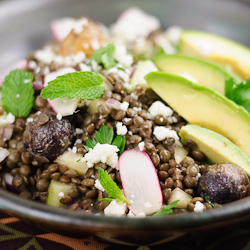 Fresh herbs: I know I made fun of parsley sprigs, but parsley and other fresh herbs can be fantastic. They should go on the food, not next to it, and the flavor should make sense in the context of the dish, like the mint and parsley on this Latin-American French Lentil Salad.
Fresh herbs: I know I made fun of parsley sprigs, but parsley and other fresh herbs can be fantastic. They should go on the food, not next to it, and the flavor should make sense in the context of the dish, like the mint and parsley on this Latin-American French Lentil Salad.
 Vegetables: finely diced cucumbers, thinly sliced jalapeno, cherry tomato halves, and quick fresh salsas add crunch and refreshment. I especially love green onions, like on this Tofu and Kimchi Dinner for One.
Vegetables: finely diced cucumbers, thinly sliced jalapeno, cherry tomato halves, and quick fresh salsas add crunch and refreshment. I especially love green onions, like on this Tofu and Kimchi Dinner for One.
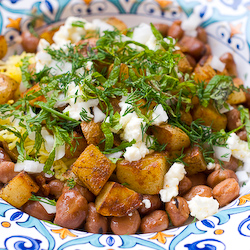 Cheese: Parmigiano reggiano, pecorino romano and grated cheddar are all obvious choices, but don't forget crumbled feta or ricotta salata.
Cheese: Parmigiano reggiano, pecorino romano and grated cheddar are all obvious choices, but don't forget crumbled feta or ricotta salata.
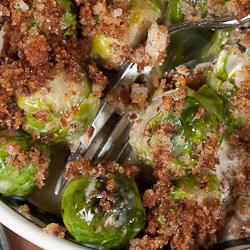 Homemade breadcrumbs add great crunch; they can be plain or flavored with garlic or herbs. Adding them for just the final few minutes of cooking in the Brussels Sprout Gratin ensures they stay crisp.
Homemade breadcrumbs add great crunch; they can be plain or flavored with garlic or herbs. Adding them for just the final few minutes of cooking in the Brussels Sprout Gratin ensures they stay crisp.
 Simple sauces like pesto, chermoula or chimichurri come together in just a few minutes. A mini-food processor is the ideal tool for making them in small batches.
Simple sauces like pesto, chermoula or chimichurri come together in just a few minutes. A mini-food processor is the ideal tool for making them in small batches.
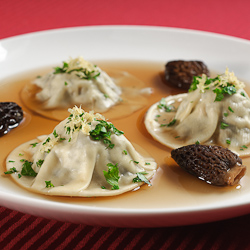 Citrus zests create incredibly appetizing aromas when grated with a microplane at the very last moment. Lemon, of course but don't forget oranges, lime, grapefruit and so on.
Citrus zests create incredibly appetizing aromas when grated with a microplane at the very last moment. Lemon, of course but don't forget oranges, lime, grapefruit and so on.
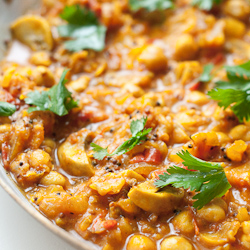 Spices require a delicate hand, but a very light dusting of smoked paprika or garam masala can be amazing. In Indian cuisine, they may be quickly cooked into a tempering - sizzled in ghee and drizzled on the main dish (like in this Chana Mushroom Masala).
Spices require a delicate hand, but a very light dusting of smoked paprika or garam masala can be amazing. In Indian cuisine, they may be quickly cooked into a tempering - sizzled in ghee and drizzled on the main dish (like in this Chana Mushroom Masala).
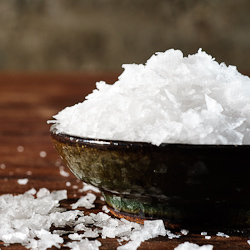 Finishing salts add texture and salinity. There is something very different about salt on the surface of a dish, meeting your taste buds before the rest of the food vs. salt throughout.
Finishing salts add texture and salinity. There is something very different about salt on the surface of a dish, meeting your taste buds before the rest of the food vs. salt throughout.
So, what are some of your favorite garnishes?

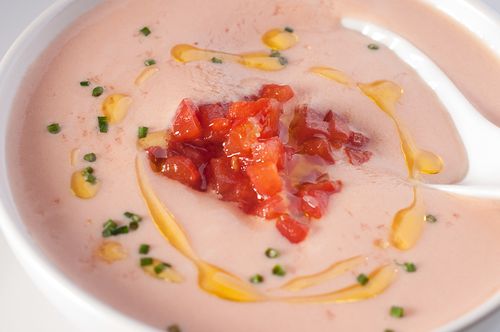
I love a swirl of harissa in my carrot soup, and something as simple as a drizzle of olive oil can make a huge difference for almost anything.
wow! great job!! excellent photos. inspirational …..
thanks!
Love your photography. Thanks for sharing.
Diana
I still prefer fresh herbs, or flowers, unless the garnish flavour has to be part of the recipe for some reason, it should be not intrusive taste-wise.
To me a garnish is not a condiment :-). What do you think?
wonderfull piece on garnishing, thanks for sharing it.
I think herbs are the best as one can not go wrong with that and veg garnishing am trying my hand at that. but again, garnishing should be complementing rather than intrusive. too much of it can spoil the dish.
Lovely thought provoking post Michael.I must say, plating food in context to both garnishes and food styling is not my strong point. In fact, I think I’m actually in the developmentally delayed category. A sprig of parsley is being super creative that day for me. So this has been a subject dear and sore to my heart. That said, I do love using fresh herbs in a million ways. Also smoked paprika is my superstar. I love it love it love it. Thanks for the great post.
Ciao Michael, I answered you in my blog, but I copy here for convenience:
I don’t take measures for crescentine, but it is more or less this: http://alessandrazecchini.blogspot.com/2008/09/basic-pizza-dough.html
plus 50 more g of flour, and if your flour is not strong add a little gluten :-). Every family makes a slightly different dough, but it is the cooking method that counts here 🙂
ciao
A.
Your right. Most see garnishing is just a look good for the food. But I like to use herbs and vegetables to garnish and for taste. When you cut up many vegetables the make the food look good and also adds taste. I am glad you posted this article.
Thanks
Aline
recipe club
Those pictures look great. I also like to garnish our food with herbs or something. It just makes what you are eating that more enjoyable.
The tomato or radish rose is so 70s. You’re absolutely right that garnishes should explode with flavor and enhance the dish. It makes very good sense. I’ve paid attention!
Thanks for the great ideas for garnishes!
This is why our family likes Mexican night: meat for those who eat it, beans, rice, tortillas and a whole host of garnishes!
My favorites are cilantro and green onions.
Gremolata is among the best: an explosion of parsley citrus and garlic goodness. It’s not my most used though. That would have to be whatever herbs seem most appropriate.
Seeds or ground nuts are great too. I’m surprised they didn’t make the list.
What is that recipe that’s the title picture?! That amazing looking pink soup [?] with the olive oil and chives [?] on top?! I just want to eat it!!!! Please, point me in the right direction!
Ah! That is a cold tomato confit-buttermilk soup. It will be in the book (coming out next spring: http://bit.ly/d5Ykpe)
Michael Natkin
Find me:
The latest from my blog, Herbivoracious: Double Crust Pizza with Broccoli Raab, Ricotta and Caramelized Onions – Recipe
Thanks for the great ideas for garnishes!
I love a swirl of harissa in my carrot soup, and something as simple as a drizzle of olive oil can make a huge difference for almost anything.